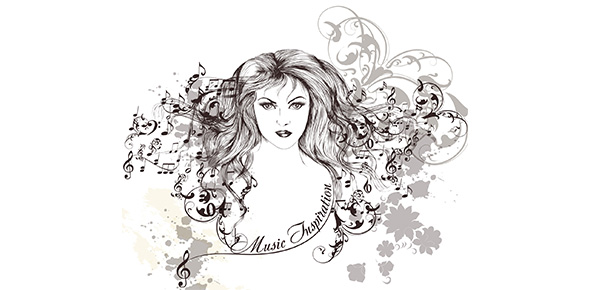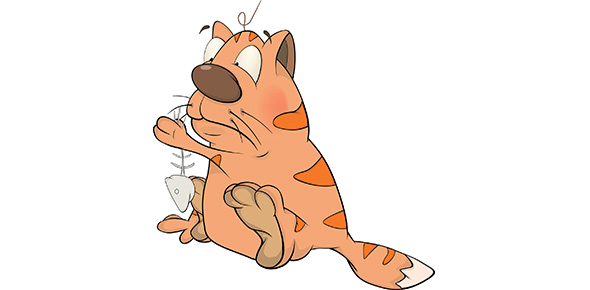Related Flashcards
Related Topics
Cards In This Set
| Front | Back |
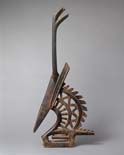 Bamana Mande |
Bamana-mande, ciwara headdress, 19th early 20th century, Mali A second type of headdress, characterized by strong abstraction, is essentially found in the southwestern Ouassoulou region. It shows a combination of three different species of animal : the aardvark (timba), the pangolin (n’koso kasa) and the roan antelope (dega). The base of the headdress is formed by a representation of the aardvark. Here it is recognizable from the elongated head, pointed ears and bend legs. The structure on the aardvark’s back, circumscribed by a nearly closed oval, represents a pangolin in the rolled-up position it assumes in defense and to protect its young. This stylized figure is surmounted by two vertical elements and by the horns and long, pointed ears of an antelope (see picture n° 2). This mask is worn during ritual dances intended to ensure the fertility of the fields. For the Bamana, therefore, these three animals are symbolically linked with tilling the soil, including its sexual connotations. Sexuality and agricultural activity are closely related in their minds, since both ensure human survival. A female figure is sometimes mounting the pangolin (see picture n° 3). This is a reference of farming because the largest a Bamana man’s harvest is, the more demand as a husband he will be, and the more wives he can support.
|
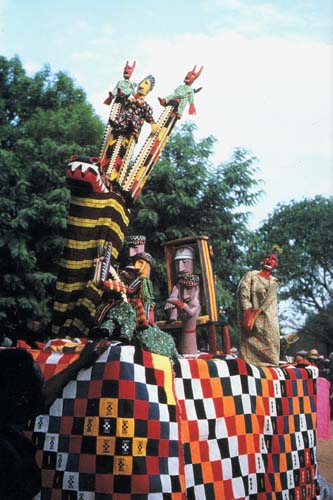 Bamana Mande |
Bamana Mande, Sogo Bo Masquerade of giraffe with puppet of former Mali President Moussa Traore .1980 Mali
The repertoire that a troupe plays in any year underscores a fundamental principle of youth theater which gives a positive value to innovation and change. The dramatic content of the youth theater is concerned with exploring the interplay between unity and rivalry, between the elders and youth, between the collective and the individual, and between tradition and change. Each season a troupe will choose to play many of the same characters popularized by their fathers and grandfathers before them. But each new generation of young men is also charged to create new characters to rival those of their elders. While the community invests a high value in unity through the maintenance of tradition, it also recognizes that creative rivalry energizes these performances, in the same way that people understand the necessity for innovation and change in order to move the society forward. Troupes creatively exploit the full spectrum of arts—puppet masquerades, dances, drumming, and songs—to construct the dramatic characters in the fictional world of Sogo bo. These performances are important sites for the exploration of the moral universe. Like folktales and other theatrical forms, these masquerade performances throw cultural values and social relationships into high relief and open them up for public scrutiny. Even though they are defined as entertainment, young men and women proceed with a seriousness of purpose, often mediated by wit and humor, to examine the nature of their world and their lived experiences. For generations, this theater has constituted one important public avenue through which young men and women have gained access to knowledge, instruction, and experience by commenting upon the critical beliefs and values within their communities." Mary Jo Arnoldi - Playing With Time - Art and Performance in Central Mali |
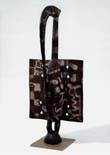 Senufo |
Senufo, sejen (bird) figure, 19th -=early 20th c. northern Core D'Ivoire
|
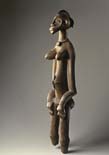 Senufo |
pombia), or "children of poro," such imposing male and female figures were the major sculptural forms commissioned by the poro association in Senufo communities of Côte d'Ivoire, Mali, and Burkina Faso. During funerals and commemorative ceremonies for distinguished association members, male figures like this one stood with female companions evoking a primordial couple. Sculptural pairs honored the deceased as they entered the society of ancestral spirits and recalled their lineage extending back to their earliest ancestors. On these occasions, poro members displayed pombibele figures in architectural settings or tapped them on the ground to the rhythm of drums in a procession.
Although poro is essentially a male institution, the most important ancestor invoked is a woman, the head of the poro chapter's founding matrilineage. Senufo artists often rendered female representations taller than their male companions. Their asymmetrical treatment of poro sculptural couples emphasizes the importance of women as matrices of life
|
|
Senufo
|
Senufo, Kpeliye's face mask 19th -early 20th c Northern Cote D'Ivoire Collected 1939"It is a delicately carved mask combining both human and animal features. Although it was always owned
and worn by a man, Kpelie represented the concept of feminine beauty and fertility. The unique features which characterize the Kpelie mask include elongated flanges radiating from the bottom part of the mask, which are a reference to the hornbill bird. The horns on the mask refer to the ram, an important sacrificial animal. The nodules on the forehead represent palm nuts as well as vulvas; they are flanked by cicatrization marks that symbolize the twins born to the primordial couple. The Kpelie mask was used at initiation in the societies for boys, adolescents, and adults, at funeral rituals designed to lead the spirit into the land of the dead, and at harvest festivals to thank the ancestors for a good crop. Kpelie- whether in carved wood or cast bronze copper alloy-- are usually oval in shape with arched crescent shaped eyebrows over narrow slit eyes. The small mouth opens below a slender nose. Scarification marks add to presentation of what is considered beautiful to the Senufo. On either side of the temples are semicircular and rectangular shapes that represent the stylized coiffure worn by Senufo mothers; the center shapes at the side representing ears. Animal horns-- bull, ram or antelope-- represent male attributes of the masquerade. There are often two appendages on either side of the chin, "legs" that connect the spirit to the earth. Most important are the figures on the head, which represent an ancestor closely connected with the society's origin. The figures worn depend on the caste group to which the individuals belong. However, much of the original significance of these emblems is no longer valid. Wassing has provided the following meanings: a comb, the symbol of agriculture, a bird- especially the hornbill-- linked with the smiths, a bundle of palm nuts, symbol of wood carvers, and small human figures connected with merchants. The hornbill--one of the first creatures on earth-- is an important symbol for the Senufo and appears on many of their carvings |
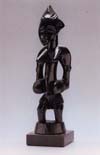 Senufo |
Senufo, Madeo divination figure. 19th early 20th century. Northern Cote D'Ivoire Divinatory spirits and sculptures created for them are often referred to as ndebele, madebele, and tugubele (sing.: ndeo, madeo, and tugu) in several Senufo dialects used in northern Côte d'Ivoire, southeastern Mali, and southwestern Burkina Faso. This is smooth and shiny because it has been rubbed with palm oil/shea butter. The lines at her waist are what woman should wear there. Beads. People commonly link divinatory spirits with nature, namely water, trees, and uncultivated landscapes beyond town and city limits. They conceive of nature spirits as anthropomorphic beings with feet that point backwards, often invisible to the human eye. According to these beliefs, nature spirits may assist people to maintain good health, achieve success, and develop satisfactory relationships with friends and family. Spirits can also be held accountable for people's illness or hardship, however, and are regarded with ambivalence. Hunters, farmers, and others who enter the wilderness or who otherwise come into contact with trees and natural water sources consider risks taken when they approach places where nature spirits are believed to reside. They rely on preemptive measures designed to appease spirits who may be offended when people track game, till the land, draw water, or otherwise invade spirit domains. Diviners similarly commission sculptures to appeal to capricious spirits and seek their goodwill. The diversity of divinatory arts attests to diviners' perceptions of nature spirits' unique preferences and artists' interpretations of them.
|
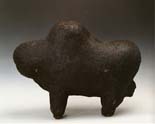 Bamana Mande or Senufo |
Artist: Nadano Soro. Bamana Mande or Senufo, Boli power object, 19th early 20th century
A rough, cracked surface obscures exact identification of the organic and inorganic materials assembled to create the boli (pl.: boliw), or power object, shown here. Leaders of West African power associations manipulate diverse media to create boliw in human, bovine, and elliptical forms. The sculptures range in size from portable works that fit into bags and attaché cases to almost human-sized constructions. Their striking forms suggest the knowledge and skill of the individuals who built them, while their elusive ingredients underscore restrictions placed on knowledge exchange. Power association leaders develop intricate formulas that allow them to harness incredible material and metaphysical potential, including nyama, a potent force that unleashes great destruction when mismanaged. To that end, they study the unique properties of flora, fauna, and other elements and combine them in infinite ways. However, power association leaders obfuscate their knowledge due to the potential for such knowledge to cause harm. Boliw result from experts' deliberate calculations and determined efforts to wield incredible energy. The sculptures' surfaces appear impenetrable to uneducated beholders and conceal the powerful ingredients they contain.
|
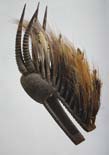 Bamana Mande or Senufo |
Bamana Mande or Senufo, Komo or kono mask, 19th-early 20th c. Guinea, Mali, Burkina Faso, Cote d'Ivoire.The Komo, a "speaking" kaceene, was probably introduced in the Tagwa region at the end of the eighteenth century from Bamana. It is said in one of the Komo's songs: "Komo ye Bamana fin loye, Komo ye nurnu ya loye" ("Komo is a product of the Bamana, Komo is the fact of the blacksmith"). In addition, Komo maskers speak and sing in the Bamana language during the performance and use a translator called Yelema ("translator" in the Bamana language) to interpret their messages to the audience. Tagwa believe that Komo is a spirit that is above man, sent by Kle, with supernatural power to help people to solve their problems. Komo behaves as a police officer and benefactor ben·e·fac·tor
n. One that gives aid, especially financial aid. [Middle English, from Late Latin, from Latin benefacere, to do a service; see benefaction. of society. The Komo is a protector spirit of its members. According to Ousmane Traore from Sountourkou, the Kono, called Koundo by the Tagwa, was created by the Tagwa for the purpose of playing the same role as the Komo, that is, to protect society from malevolent persons but, more importantly, to entertain their members and the community. The Kono mask is similar in style to the Komo one, and a blacksmith carves both. The Kono's costume has bird feathers only on the back of a combined shirt and pants. Contrary to the Komo, the Kono mask and performance can be seen by the Djeli, but not by all women. It is only seen by women born under its protection, as is the case with the Komo. The Kono's accompanist is called Djeliba ('bard' in the Dyula language) and does not follow the Kono masker mask·er also mas·quer Kono Masks are simple. Don't need all of the stuff because of what's in the pouch. |




